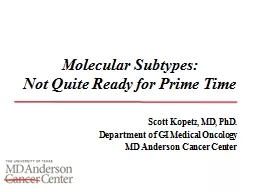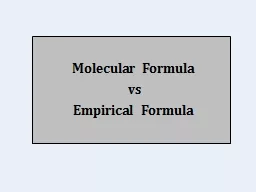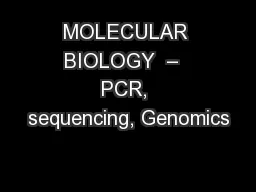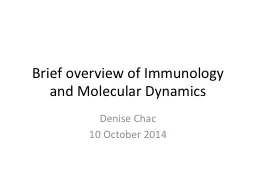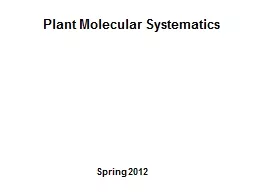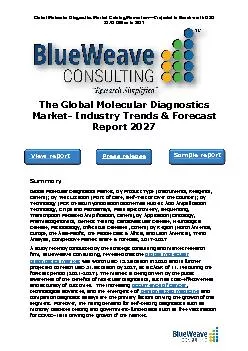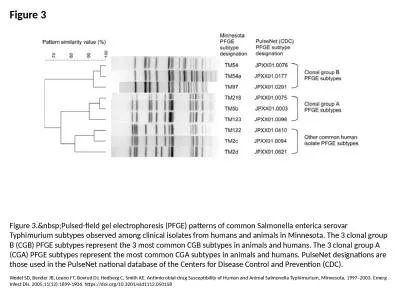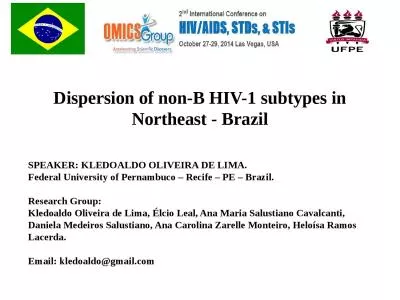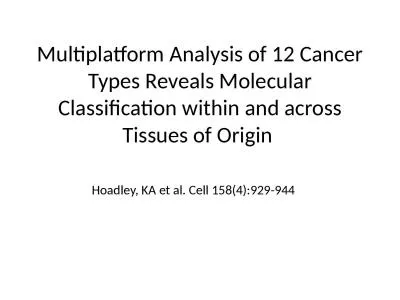PPT-Molecular Subtypes:
Author : giovanna-bartolotta | Published Date : 2017-11-04
Not Quite Ready for Prime Time Scott Kopetz MD PhD Department of GI Medical Oncology MD Anderson Cancer Center NOT YET YES Individual Biomarkers versus Molecular
Presentation Embed Code
Download Presentation
Download Presentation The PPT/PDF document "Molecular Subtypes:" is the property of its rightful owner. Permission is granted to download and print the materials on this website for personal, non-commercial use only, and to display it on your personal computer provided you do not modify the materials and that you retain all copyright notices contained in the materials. By downloading content from our website, you accept the terms of this agreement.
Molecular Subtypes:: Transcript
Not Quite Ready for Prime Time Scott Kopetz MD PhD Department of GI Medical Oncology MD Anderson Cancer Center NOT YET YES Individual Biomarkers versus Molecular Subtypes Individual biomarkers. Over the past decade an ever growing arsenal of techniques has helped researchers dissect the innermost secrets of the cell and develop new ways to detect and attack disease These techniques also have been used to produce vast amounts of once rare d European Molecular Imaging Doctoral School. Expert . training. in Molecular Imaging. Promote PhD student . mobility. Molecular . Imaging Professional. Academic. Industry. European Molecular Imaging Doctoral School. . vs. . Empirical Formula. Different compounds can have the . same. empirical formula. but . different. molecular formulas. .. Empirical . Formula is a . reduced. . form of Molecular formula . Molecular Formula and Empirical Formula. MOLECULAR BIOLOGY TECHNIQUES II.. Polymerase Chain Reacton – PCR. DNA sequencing. Amplification of specific DNA fragments. MOLECULAR BIOLOGY – PCR. Cloning and/ or isolation from a genomic library . BIKER. CAMPER. RUNNER. d. Problem 6. a. At a given time, a person must be exactly one of these subtypes.. PERSON. BIKER. CAMPER. RUNNER. d. Problem 6. b. A person may or may not be one of these subtypes. However, a person who is one of these subtypes cannot at the same time be one of the other subtypes.. Denise Chac. 10 October 2014. Immunology. The study of the human immune system . Lymphocytes. B Cells. Membrane bound antibody. Activation: bind to pathogen and triggered by helper T cells. MHC II proteins present antigen peptide on cell surface. Spring . 2012. “Problems” with morphological. data…. Convergence and parallelisms. Reduction and character loss. Phenotypic vs. genotypic differences. Evaluation of homology. Misinterpretation of change or polarity. MMPBSA. D. G. free. D. G. bound. (1) Use free energy perturbation methods to estimate relative free energies. . DD. G =. D. G. free. - . D. G. bound. how to estimate free energies?. D. G?. ?. (2) Estimate potential of mean force along pathway? (but, what. The global molecular diagnostics market was worth USD 15.29 billion in 2020 and is further projected to reach USD 31.98 billion by 2027, at a CAGR of 11.1% during the forecast period (2021-2027). REV SP NFE DIG (A) Drossman DA, Morris CB, Schneck S, et al. International survey of patients with IBS: Symptom features and their severity, health status, Nastaskin I, Mehdikhani E, Conklin J, et al. ;. . the. . study of . biology. at the . molecular. level.. Molecular biology. ;. . the. . study of . gene . structure and functions at the . molecular level. . to understand the molecular basis of hereditary, genetic variation, and the expression patterns of genes. . Wedel SD, Bender JB, Leano FT, Boxrud DJ, Hedberg C, Smith KE. Antimicrobial-drug Susceptibility of Human and Animal Salmonella Typhimurium, Minnesota, 1997–2003. Emerg Infect Dis. 2005;11(12):1899-1906. https://doi.org/10.3201/eid1112.050158. subtypes. in . Northeast. - . Brazil. SPEAKER: KLEDOALDO OLIVEIRA DE LIMA.. Federal . University. . of. Pernambuco – Recife – PE – . Brazil. .. Research. . Group. :. Kledoaldo. Oliveira de . Hoadley. , KA et al. Cell 158(4):929-944. Background. Cancers classified based on pathological criteria – tissue site of origin. TCGA reported genome-wide studies of 10 malignancies. Each single-tissue cancer type can be divided into 3-4 molecular subtypes.
Download Document
Here is the link to download the presentation.
"Molecular Subtypes:"The content belongs to its owner. You may download and print it for personal use, without modification, and keep all copyright notices. By downloading, you agree to these terms.
Related Documents

